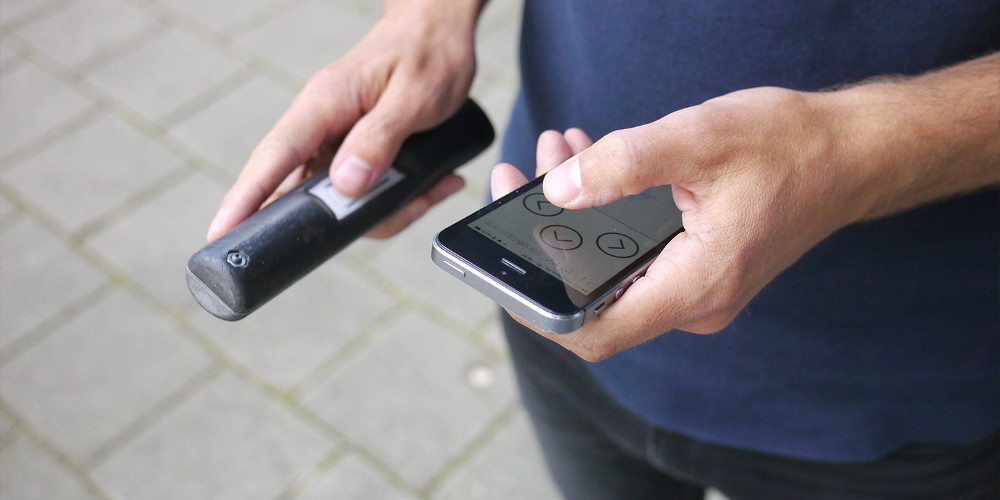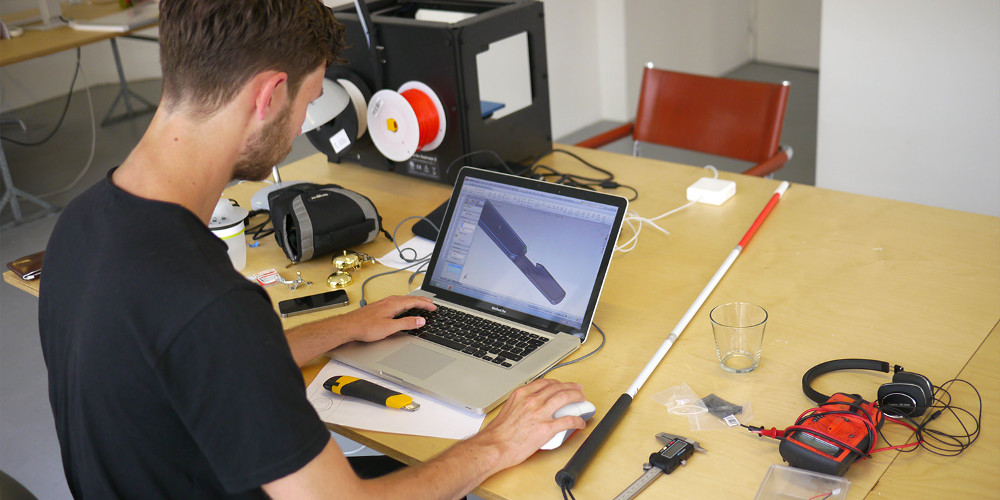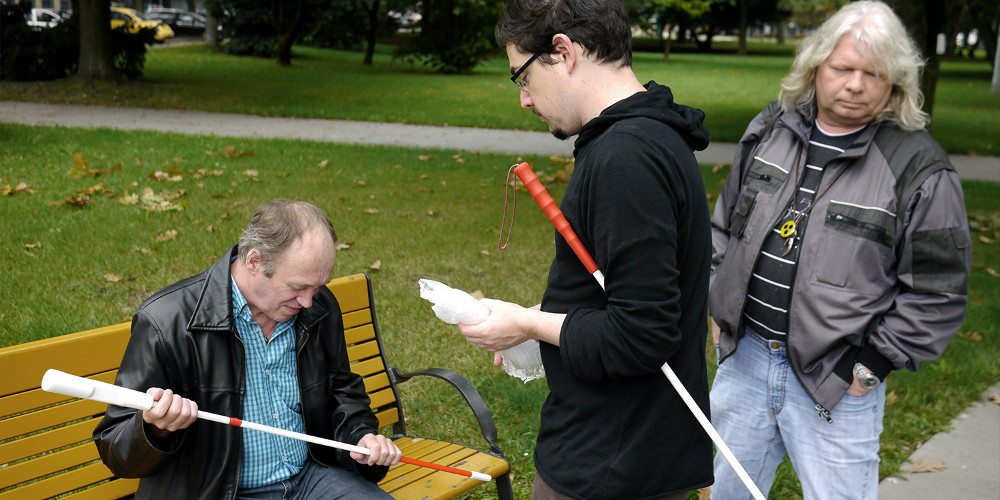 Picture: blindmaps.org
Picture: blindmaps.org
The research project BlindMaps was the winner of this year’s [the next idea] voestalpine Art and Technology Grant – an art and technology grant to honor new and extraordinarily promising ideas and to support the process of developing them further. In the beginning of June we reported in an interview with Markus Schmeiduch, that BlindMaps is a research project that has taken on the difficult task of developing a navigation system for use by blind and visually impaired men and women making their way through big cities in which they’re strangers.
With support of a stipend in the amount of 7,500 Euro, which Voest Alpine enabled, it was possible for the winners to do an Artist-in-Resdence-Program at the Ars Electronica Futurelab and develop the project further.
Before the residency ended we talked to Andrew Spitz and Ruben van der Vleuten from BlindMaps to talk about the improvement of their project and experienced that the physical concept changed in 180° degrees. Although the ideology behind it is still the same.
 Picture: blindmaps.org
Picture: blindmaps.org
Hi Andrew and Ruben, how was the residency so far?
Andrew Spitz: We started the residency about one month ago. Markus came on the 28th of July to Ars Electronica Futurelab and has been working here. Ruben and I have been working on the physical side of things on the prototype at Amsterdam in our studio. So we had some collaborating parts and then we sent Markus all the prototypes and he got them into the field and tested them with the users. It has been a really good process for us to be able to take time to work pushing this idea – this concept – into something that actually exists and it’s much more realistic to implement something into people’s hands.
Ruben van der Vleuten: Yeah, we only wrote about BlindMaps for quite a couple weeks. It was really good to come here to the Futurelab to get into the field finally, because sometimes it was a bit wired. We also worked on other projects and we could not physically be here for such a long time. So it was very nice to be here and be in the surroundings of Ars Electronica.
 Picture: blindmaps.org
Picture: blindmaps.org
How much could you evolve BlindMaps since you won the residency at Prix Ars Electronica?
Andrew Spitz: Well, when we originally started BlindMaps we worked off all the assumptions. We made a lot of guesses, based on what we knew and what we thought would be a good product or a good thing for people to use, but then we learnt a lot from building prototypes. That was in early July. We learnt that the technology we wanted to use was not realistic at all – not feasible based on today’s world and we need a lot of time to do further developments or to actually be able to put it into a product. We also learnt from the interaction side of things – from the users, that the way we had done it doesn’t work very well.
So from that back then our ideas were very idealistic and basically through this residency we were able to really convert it into something that’s much more realistic. So it has evolved a lot. What we have today is really something that actually really works and actually really helps to navigate, what was just the question we were after.
 Picture: blindmaps.org
Picture: blindmaps.org
Ruben van der Vleuten: Yeah, I also think through this residency actually the physical concept changed in 180° degrees. Although the ideology behind it – helping blind and visually impaired people to navigate through cities and unknown areas – is still the same. Just the object and the physical output has totally changed. That was based on the experience with users and to more technological research, which are almost actually feasible and realistic. So actually we think we came a long way from something that is incredibly hard to build to something that’s realistic and we are still achieving the same goal. That’s great!
Andrew Spitz: We could also reach that other people can be involved in the project, what was also a big part of what we wanted to do. It is a platform and a kind of movement for other people to be able to join with their skills.
 Picture: blindmaps.org
Picture: blindmaps.org
How did BlindMaps change?
Ruben van der Vleuten: I basically explain what happened. In the first concept we had the device with the braille interface, where you can actually feel where you have to go. This was totally not realistic to build with our budget and it also turned out that this was not the ideal way to do it. I mean on paper it sounds nice, but in practice it doesn’t work. Then we went to another approach which is actually way more realistic. It’s a grip for a blindman’s stick and basically what’s in there is a Bluetooth module that it can communicate with a phone. At the moment we have different prototypes which contain different electronics. One has a button with one vibration motor, another one has a button with two vibration motors. What we did is using an iPhone app called BlindSquare, which is built for navigation and is based on iPhone and audio and we used that app to connect it with our physical prototypes to help people navigate. The one with two vibrations can navigate on the left or on the right side and there is a button to communicate with your phone. So the stick can tell you, you have to go left or you have to go right.
That’s one exploration. We have another exploration, where we connect the grip for the blindman’s stick with beacons. In order that they can communicate with each other. So the beacons can be placed on the streets, for example next to doors and as soon as you are close to the beacon you press the button on the stick and the beacon gives audio feedback. So you can place it on a train platform or next to a door and when you are close you can press the button and then the beacon says something like “You are on platform four” for the train or “The door is here”. Then the people can use their ears to actually go there. It’s really for close navigation.
![]() Picture: blindmaps.org
Picture: blindmaps.org
Andrew Spitz: Yeah, it really helps if you have an audio cue. If you hear something you can really quickly get a feeling for where this is in the space, because often if you get on the bus for example and you can’t see you don’t know how to orient yourself to find the stairs or the exit or something. This device provides direction and also information on the location.
Ruben van der Vleuten: So actually we are moving from a really general navigation – using GPS – to a navigation in small areas, where GPS is not sufficient, because GPS only has an accuracy of maybe 10 meters, but with this audio feedback you can get people really close. I mean this is accurate to centimetres. And that are things we have been exploring.
 Picture: blindmaps.org
Picture: blindmaps.org
Andrew Spitz: So this prototype, which connects with BlindSquare works more with GPS and is more like high level orientation in a city and as Ruben said the one with the beacon is more close range, for example indoor it works really well, because it doesn’t need GPS and GPS doesn’t work inside. So, these are two separate things, dealing with different parts of navigating in the city.
Ruben van der Vleuten: This is what we did now and now of course we test it with the users and find out which things work and which don’t work and in the end, I think, the idea would be to combine it. So you have a stick that you can combine with your phone and with beacons.
